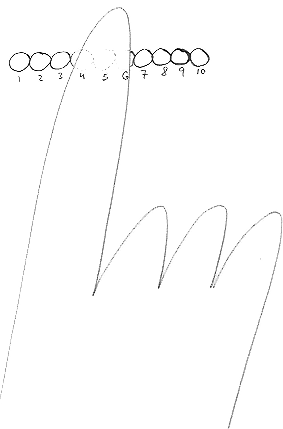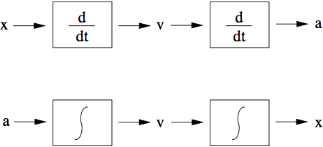Difference between revisions of "Gesture Signal Processing"
(→Interpolation) |
(→Interpolation In Space) |
||
| Line 8: | Line 8: | ||
=== Interpolation In Space === | === Interpolation In Space === | ||
| − | Now we consider interpolation in space. Given a finite number of sensors at discrete positions, we might want to estimate the continuous position of an object in space. | + | Now we consider interpolation in space. Given a finite number of sensors at discrete positions, we might want to estimate the continuous position of an object in space. For example, imagine a line of 10 force sensing resistors or capacitative sensors as shown below. |
| + | |||
| + | <center> | ||
| + | [[Image:interpolatespace.png]] | ||
| + | </center> | ||
| + | |||
| + | We can develop an estimate of the center of the user's finger using linear interpolation. Let's say that the centers of the 4th, 5th, and 6th sensors are located at the horizontal positions 20mm, 25mm, and 30mm, respectively. If '''s<sub>4</sub>''' and | ||
== Filtering == | == Filtering == | ||
Revision as of 17:14, 12 October 2008
Contents
Interpolation
Interpolation is a method of constructing new data points within the range of a discrete set of known data points.
Interpolation In Time
We have already learned about using the line~ object in Pd to interpolate in time to avoid zipper noise.
Interpolation In Space
Now we consider interpolation in space. Given a finite number of sensors at discrete positions, we might want to estimate the continuous position of an object in space. For example, imagine a line of 10 force sensing resistors or capacitative sensors as shown below.
We can develop an estimate of the center of the user's finger using linear interpolation. Let's say that the centers of the 4th, 5th, and 6th sensors are located at the horizontal positions 20mm, 25mm, and 30mm, respectively. If s4 and
Filtering
While studying sensors, we discovered that often a particular sensor will measure the position x, velocity v, or acceleration a of an object. However, we might like to use a different variable to control the way we synthesize sound. Ideally, integration and differentiation can be applied to convert between variables.
Here is a simple approximation of an integrator. In this case, we integrate an acceleration measurement in order to obtain velocity. We see that with each time step, v is updated to be nearly the same as the previous v, but it is affected by the input a. This is an example of a low-pass filter because the filter passes mainly low frequencies.
v = 0.1*a + 0.9*v;
Next we show how to approximate a differentiator, so now x represents a measured position, and v represents velocity (although the result is scaled by a constant). The extra variable r is introduced to represent the previous position measurement. Hence, the estimated velocity is the difference between the current position and the previous position. This filter is an example of a high-pass filter because it passes mainly high frequencies.
v = x - r; r = x;
Filter design is an important part of the field of signal processing. For more details, see Julius Smith's book on simple filter design.
Thresholding
Often we want to implement some sort of event detector. For instance, we may want to detect the event that the musician has struck an object such as a drum. If the musician is holding an accelerometer in his or her hand, we can detect the event by waiting for a large value or a large change in the accelerometer signal.
For more details on thresholding, see the threshold and threshold~ objects' help patches in Pd.

